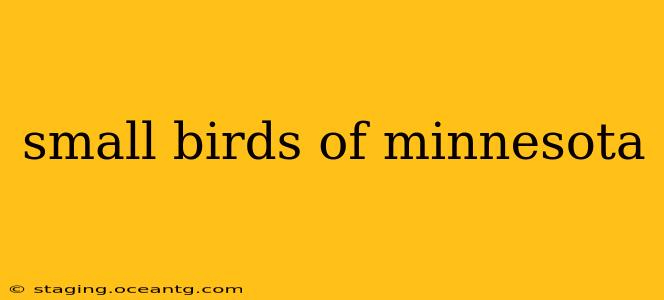Minnesota, with its diverse habitats ranging from prairies and forests to wetlands and lakeshores, boasts a rich avian population. Many small bird species call the state home, adding vibrant colors and lively songs to its landscapes. This guide explores some of the most common and fascinating small birds you're likely to encounter in Minnesota. We'll delve into their identifying features, habitats, and behaviors, ensuring you can confidently identify these feathered friends on your next nature walk.
What are some of the smallest birds in Minnesota?
Determining the absolute "smallest" is tricky as measurements can vary slightly. However, some of the consistently tiny birds frequently spotted in Minnesota include:
- Ruby-crowned Kinglet: This diminutive bird, barely larger than a hummingbird, is known for its bright red crown patch (often hidden) and constant flitting amongst branches.
- Golden-crowned Kinglet: Similar in size to its ruby-crowned cousin, the golden-crowned kinglet boasts a bright yellow crown patch. Both kinglets are incredibly active and often found in coniferous forests.
- House Wren: While not the absolute smallest, house wrens are exceptionally small and common, nesting in readily available cavities, often near human dwellings. Their loud, bubbly songs are easily recognizable.
- Brown Creeper: This tiny bird is easily overlooked due to its cryptic coloration and habit of creeping up tree trunks. Its size and constantly upward movement make it distinctive.
What are some small songbirds in Minnesota?
Many small birds in Minnesota are songbirds, renowned for their beautiful melodies. These include:
- American Goldfinch: With its bright yellow plumage (males particularly striking), the American Goldfinch is a common sight in fields and meadows. Its song is a cheerful, twittering melody.
- Dark-eyed Junco: This small, slate-colored bird is a common winter visitor to Minnesota, often found foraging on the ground in flocks. Their songs are simple but pleasant.
- Chipping Sparrow: A small, reddish-brown sparrow with a distinctive cap, the chipping sparrow frequents open woodlands and suburban areas. Their song is a thin, high-pitched "chip."
- White-throated Sparrow: Slightly larger than some others on this list, but still considered a small songbird, this species is identified by its striking white throat stripe and distinctive song.
Where can I find small birds in Minnesota?
The best location to spot small birds depends largely on the species. However, some general guidelines include:
- Forests: Look for kinglets, creepers, and many warbler species in wooded areas.
- Fields and Meadows: American Goldfinches and various sparrows are commonly found in open habitats.
- Backyards and Parks: Many small birds, such as house wrens, chickadees, and juncos, readily utilize human-modified environments.
- Wetlands: Look for marsh wrens and other water-loving birds in wetland areas.
What is the best time of year to see small birds in Minnesota?
Birdwatching is enjoyable year-round in Minnesota, but different species migrate at different times. Spring and fall migrations offer the chance to see a greater diversity of birds, while winter brings resident species like juncos and chickadees. Summer offers opportunities to observe nesting behavior and hear the songs of many species at their peak.
How can I attract small birds to my backyard?
Creating a bird-friendly backyard is rewarding and increases your chances of observing these fascinating creatures. Key strategies include:
- Providing food sources: Offer seed mixes, suet, and hummingbird nectar to attract a range of species.
- Offering water: A birdbath or shallow dish of water provides essential hydration, especially during hot weather.
- Planting native vegetation: Native plants provide food (berries, seeds), nesting sites, and shelter.
- Providing nesting boxes: Suitable nesting boxes can attract cavity-nesting birds like wrens and chickadees.
By understanding the habitats, behaviors, and preferences of Minnesota's small birds, you can enhance your birding experiences and deepen your appreciation for the natural world. Remember to always observe birds from a respectful distance and avoid disturbing their natural behaviors. Happy birding!
